Human Resource Management Report: Analysis of HRM Practices at Tesco
VerifiedAdded on 2023/04/22
|22
|4719
|110
Report
AI Summary
This report provides a comprehensive overview of Human Resource Management (HRM), exploring its purpose, scope, and key practices. It delves into the significance of HRM in achieving organizational objectives, emphasizing workforce planning, recruitment and selection, job analysis and design, performance management, training and development, and reward systems. The report also examines employee engagement and employee relations, highlighting their impact on productivity and employee loyalty. Furthermore, it discusses the importance of employee relations in influencing HRM decision-making and the relevance of employment legislation. The report uses Tesco as a case study to illustrate various HRM practices, including job descriptions, personal specifications, interview questions, and job offer letters. It concludes with recommendations for improving the recruitment and selection process, providing valuable insights into effective HRM strategies.
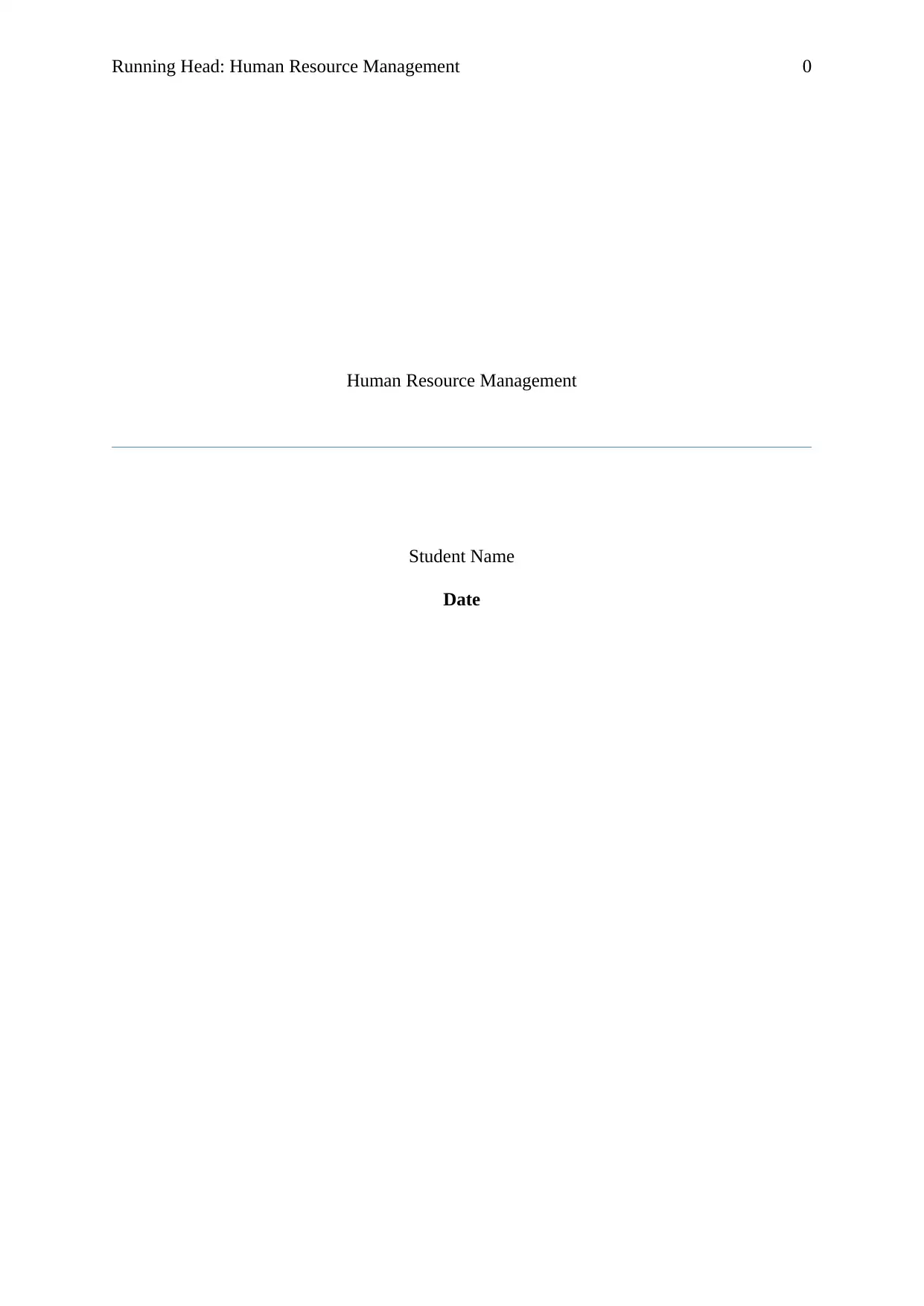
Running Head: Human Resource Management 0
Human Resource Management
Student Name
Date
Human Resource Management
Student Name
Date
Paraphrase This Document
Need a fresh take? Get an instant paraphrase of this document with our AI Paraphraser
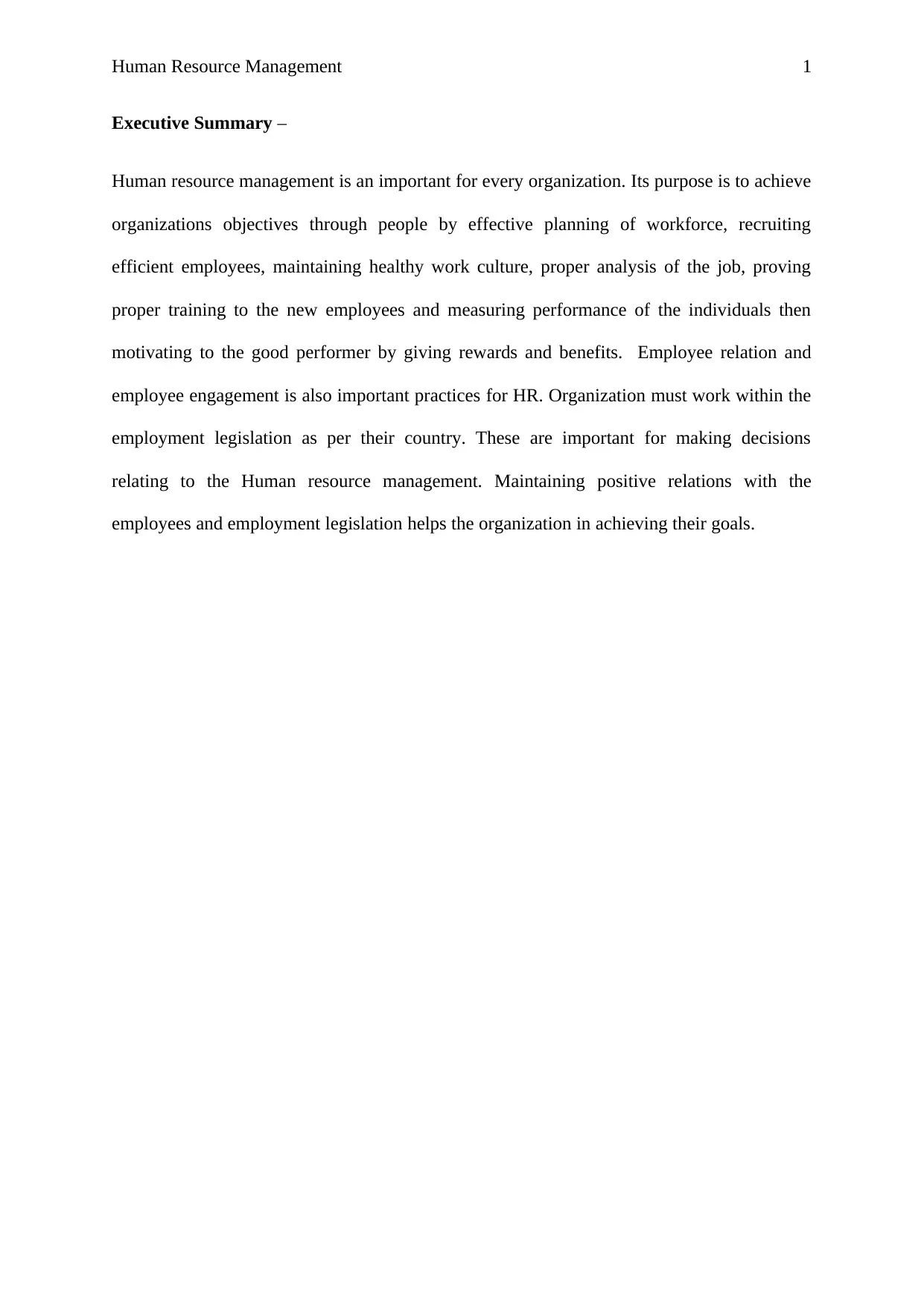
Human Resource Management 1
Executive Summary –
Human resource management is an important for every organization. Its purpose is to achieve
organizations objectives through people by effective planning of workforce, recruiting
efficient employees, maintaining healthy work culture, proper analysis of the job, proving
proper training to the new employees and measuring performance of the individuals then
motivating to the good performer by giving rewards and benefits. Employee relation and
employee engagement is also important practices for HR. Organization must work within the
employment legislation as per their country. These are important for making decisions
relating to the Human resource management. Maintaining positive relations with the
employees and employment legislation helps the organization in achieving their goals.
Executive Summary –
Human resource management is an important for every organization. Its purpose is to achieve
organizations objectives through people by effective planning of workforce, recruiting
efficient employees, maintaining healthy work culture, proper analysis of the job, proving
proper training to the new employees and measuring performance of the individuals then
motivating to the good performer by giving rewards and benefits. Employee relation and
employee engagement is also important practices for HR. Organization must work within the
employment legislation as per their country. These are important for making decisions
relating to the Human resource management. Maintaining positive relations with the
employees and employment legislation helps the organization in achieving their goals.
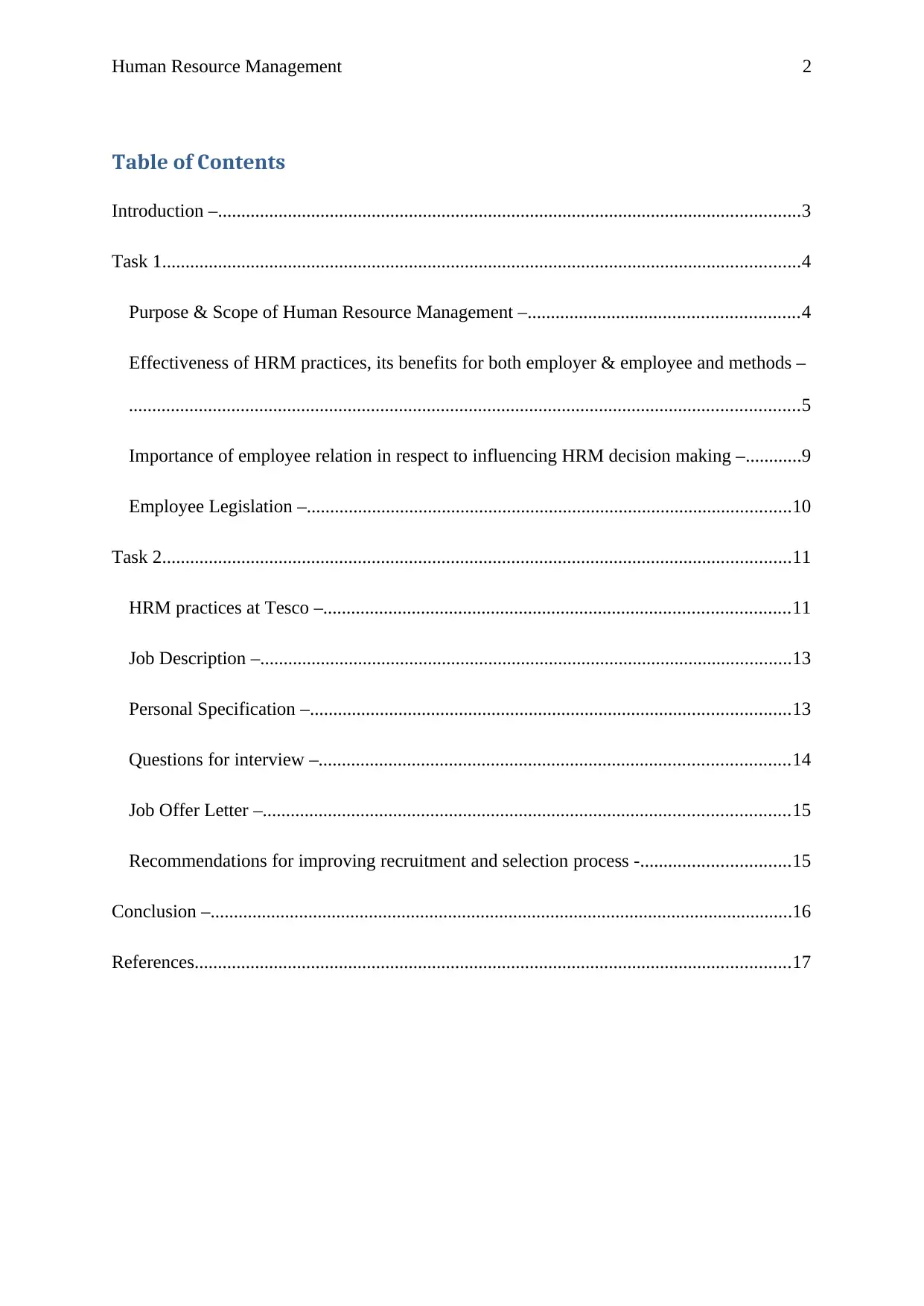
Human Resource Management 2
Table of Contents
Introduction –.............................................................................................................................3
Task 1.........................................................................................................................................4
Purpose & Scope of Human Resource Management –..........................................................4
Effectiveness of HRM practices, its benefits for both employer & employee and methods –
................................................................................................................................................5
Importance of employee relation in respect to influencing HRM decision making –............9
Employee Legislation –........................................................................................................10
Task 2.......................................................................................................................................11
HRM practices at Tesco –....................................................................................................11
Job Description –..................................................................................................................13
Personal Specification –.......................................................................................................13
Questions for interview –.....................................................................................................14
Job Offer Letter –.................................................................................................................15
Recommendations for improving recruitment and selection process -................................15
Conclusion –.............................................................................................................................16
References................................................................................................................................17
Table of Contents
Introduction –.............................................................................................................................3
Task 1.........................................................................................................................................4
Purpose & Scope of Human Resource Management –..........................................................4
Effectiveness of HRM practices, its benefits for both employer & employee and methods –
................................................................................................................................................5
Importance of employee relation in respect to influencing HRM decision making –............9
Employee Legislation –........................................................................................................10
Task 2.......................................................................................................................................11
HRM practices at Tesco –....................................................................................................11
Job Description –..................................................................................................................13
Personal Specification –.......................................................................................................13
Questions for interview –.....................................................................................................14
Job Offer Letter –.................................................................................................................15
Recommendations for improving recruitment and selection process -................................15
Conclusion –.............................................................................................................................16
References................................................................................................................................17
⊘ This is a preview!⊘
Do you want full access?
Subscribe today to unlock all pages.

Trusted by 1+ million students worldwide
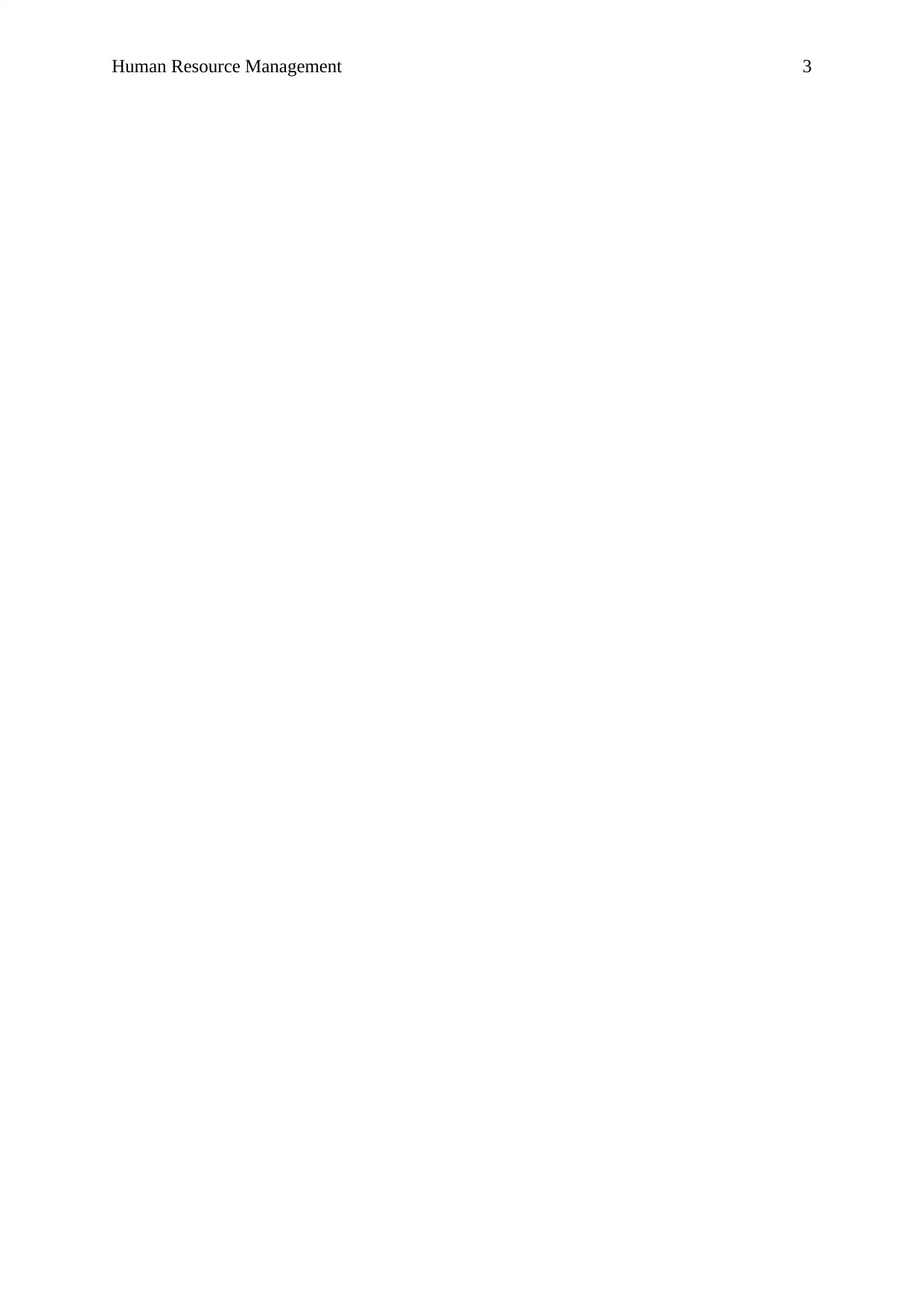
Human Resource Management 3
Paraphrase This Document
Need a fresh take? Get an instant paraphrase of this document with our AI Paraphraser
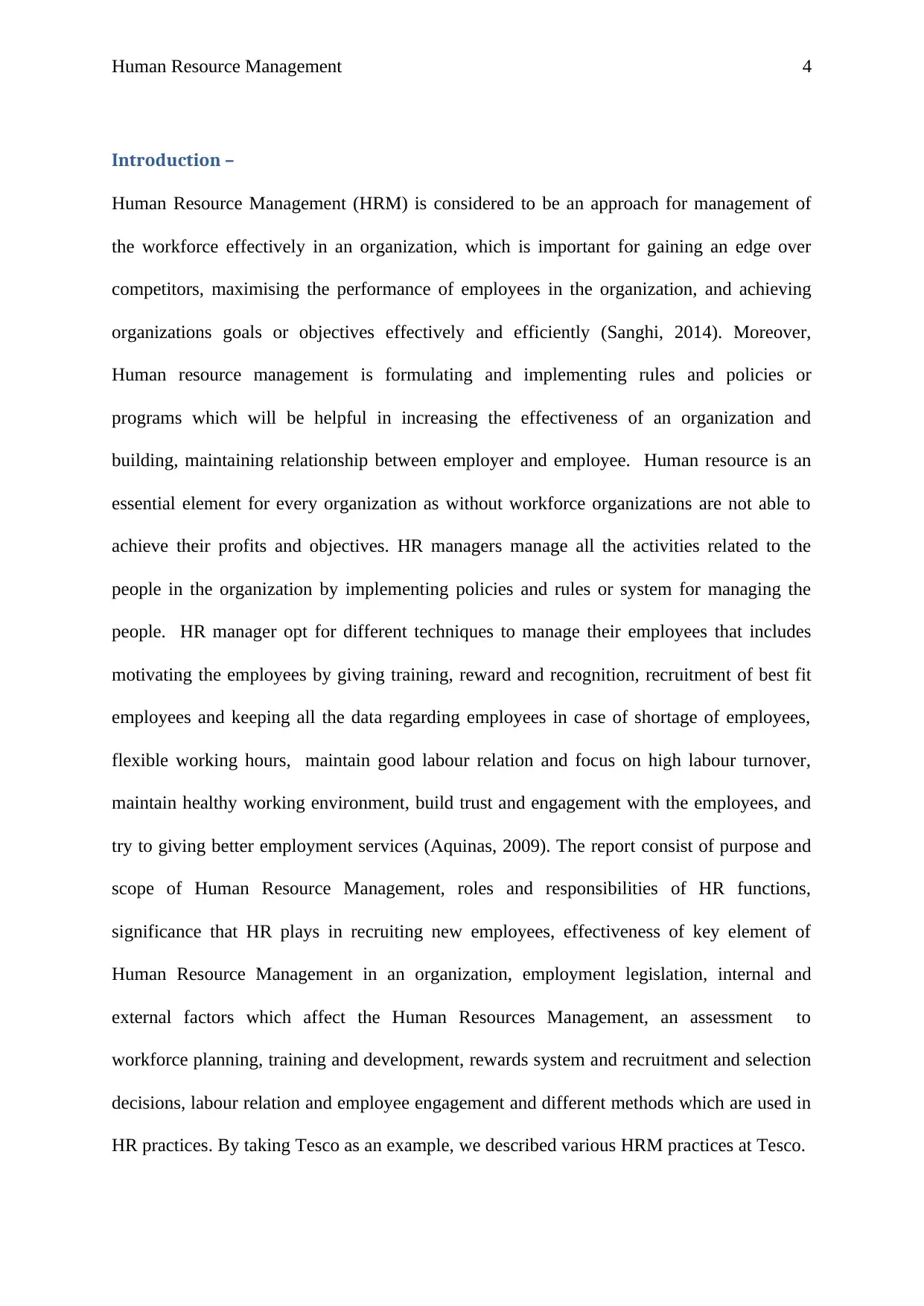
Human Resource Management 4
Introduction –
Human Resource Management (HRM) is considered to be an approach for management of
the workforce effectively in an organization, which is important for gaining an edge over
competitors, maximising the performance of employees in the organization, and achieving
organizations goals or objectives effectively and efficiently (Sanghi, 2014). Moreover,
Human resource management is formulating and implementing rules and policies or
programs which will be helpful in increasing the effectiveness of an organization and
building, maintaining relationship between employer and employee. Human resource is an
essential element for every organization as without workforce organizations are not able to
achieve their profits and objectives. HR managers manage all the activities related to the
people in the organization by implementing policies and rules or system for managing the
people. HR manager opt for different techniques to manage their employees that includes
motivating the employees by giving training, reward and recognition, recruitment of best fit
employees and keeping all the data regarding employees in case of shortage of employees,
flexible working hours, maintain good labour relation and focus on high labour turnover,
maintain healthy working environment, build trust and engagement with the employees, and
try to giving better employment services (Aquinas, 2009). The report consist of purpose and
scope of Human Resource Management, roles and responsibilities of HR functions,
significance that HR plays in recruiting new employees, effectiveness of key element of
Human Resource Management in an organization, employment legislation, internal and
external factors which affect the Human Resources Management, an assessment to
workforce planning, training and development, rewards system and recruitment and selection
decisions, labour relation and employee engagement and different methods which are used in
HR practices. By taking Tesco as an example, we described various HRM practices at Tesco.
Introduction –
Human Resource Management (HRM) is considered to be an approach for management of
the workforce effectively in an organization, which is important for gaining an edge over
competitors, maximising the performance of employees in the organization, and achieving
organizations goals or objectives effectively and efficiently (Sanghi, 2014). Moreover,
Human resource management is formulating and implementing rules and policies or
programs which will be helpful in increasing the effectiveness of an organization and
building, maintaining relationship between employer and employee. Human resource is an
essential element for every organization as without workforce organizations are not able to
achieve their profits and objectives. HR managers manage all the activities related to the
people in the organization by implementing policies and rules or system for managing the
people. HR manager opt for different techniques to manage their employees that includes
motivating the employees by giving training, reward and recognition, recruitment of best fit
employees and keeping all the data regarding employees in case of shortage of employees,
flexible working hours, maintain good labour relation and focus on high labour turnover,
maintain healthy working environment, build trust and engagement with the employees, and
try to giving better employment services (Aquinas, 2009). The report consist of purpose and
scope of Human Resource Management, roles and responsibilities of HR functions,
significance that HR plays in recruiting new employees, effectiveness of key element of
Human Resource Management in an organization, employment legislation, internal and
external factors which affect the Human Resources Management, an assessment to
workforce planning, training and development, rewards system and recruitment and selection
decisions, labour relation and employee engagement and different methods which are used in
HR practices. By taking Tesco as an example, we described various HRM practices at Tesco.
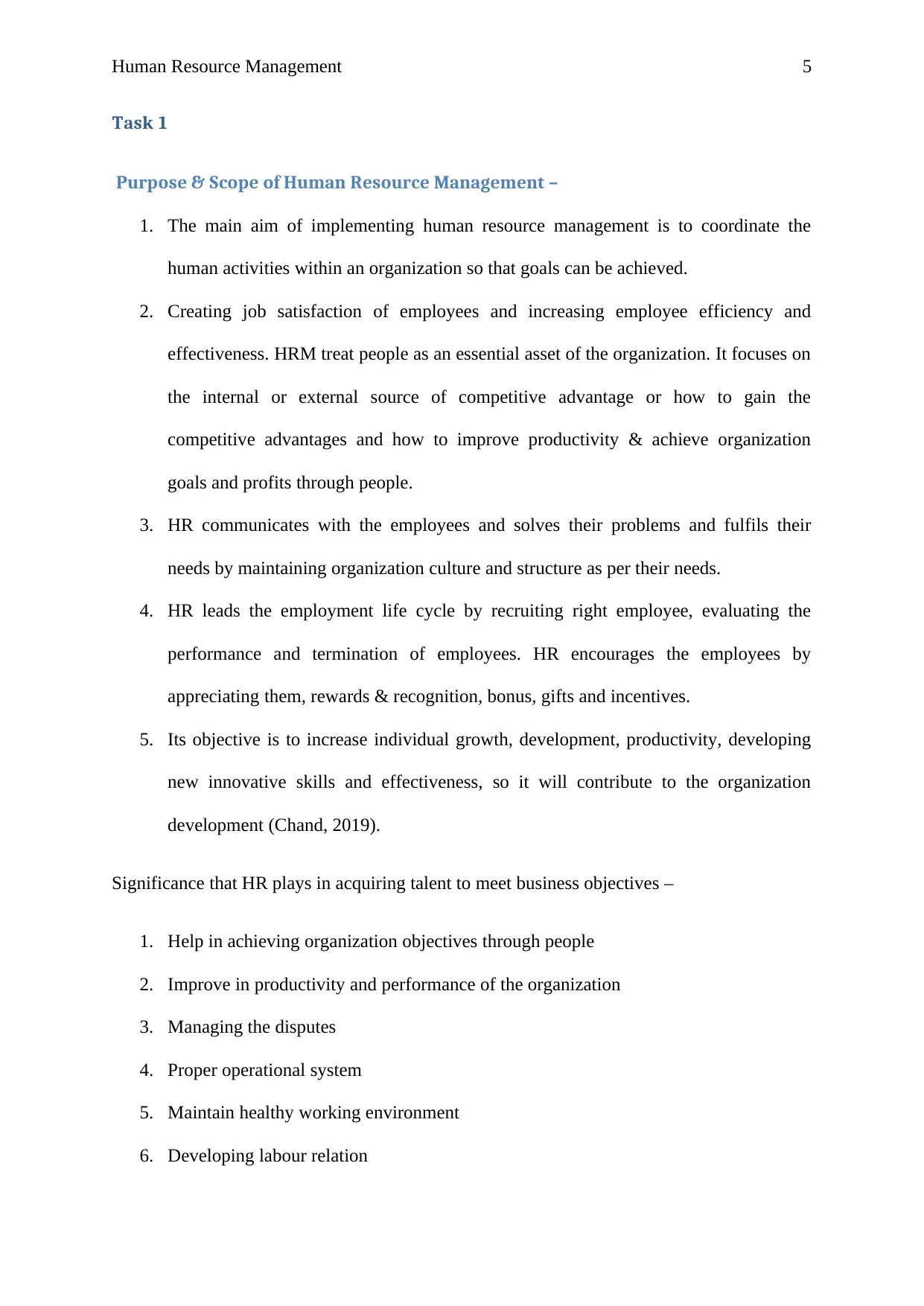
Human Resource Management 5
Task 1
Purpose & Scope of Human Resource Management –
1. The main aim of implementing human resource management is to coordinate the
human activities within an organization so that goals can be achieved.
2. Creating job satisfaction of employees and increasing employee efficiency and
effectiveness. HRM treat people as an essential asset of the organization. It focuses on
the internal or external source of competitive advantage or how to gain the
competitive advantages and how to improve productivity & achieve organization
goals and profits through people.
3. HR communicates with the employees and solves their problems and fulfils their
needs by maintaining organization culture and structure as per their needs.
4. HR leads the employment life cycle by recruiting right employee, evaluating the
performance and termination of employees. HR encourages the employees by
appreciating them, rewards & recognition, bonus, gifts and incentives.
5. Its objective is to increase individual growth, development, productivity, developing
new innovative skills and effectiveness, so it will contribute to the organization
development (Chand, 2019).
Significance that HR plays in acquiring talent to meet business objectives –
1. Help in achieving organization objectives through people
2. Improve in productivity and performance of the organization
3. Managing the disputes
4. Proper operational system
5. Maintain healthy working environment
6. Developing labour relation
Task 1
Purpose & Scope of Human Resource Management –
1. The main aim of implementing human resource management is to coordinate the
human activities within an organization so that goals can be achieved.
2. Creating job satisfaction of employees and increasing employee efficiency and
effectiveness. HRM treat people as an essential asset of the organization. It focuses on
the internal or external source of competitive advantage or how to gain the
competitive advantages and how to improve productivity & achieve organization
goals and profits through people.
3. HR communicates with the employees and solves their problems and fulfils their
needs by maintaining organization culture and structure as per their needs.
4. HR leads the employment life cycle by recruiting right employee, evaluating the
performance and termination of employees. HR encourages the employees by
appreciating them, rewards & recognition, bonus, gifts and incentives.
5. Its objective is to increase individual growth, development, productivity, developing
new innovative skills and effectiveness, so it will contribute to the organization
development (Chand, 2019).
Significance that HR plays in acquiring talent to meet business objectives –
1. Help in achieving organization objectives through people
2. Improve in productivity and performance of the organization
3. Managing the disputes
4. Proper operational system
5. Maintain healthy working environment
6. Developing labour relation
⊘ This is a preview!⊘
Do you want full access?
Subscribe today to unlock all pages.

Trusted by 1+ million students worldwide
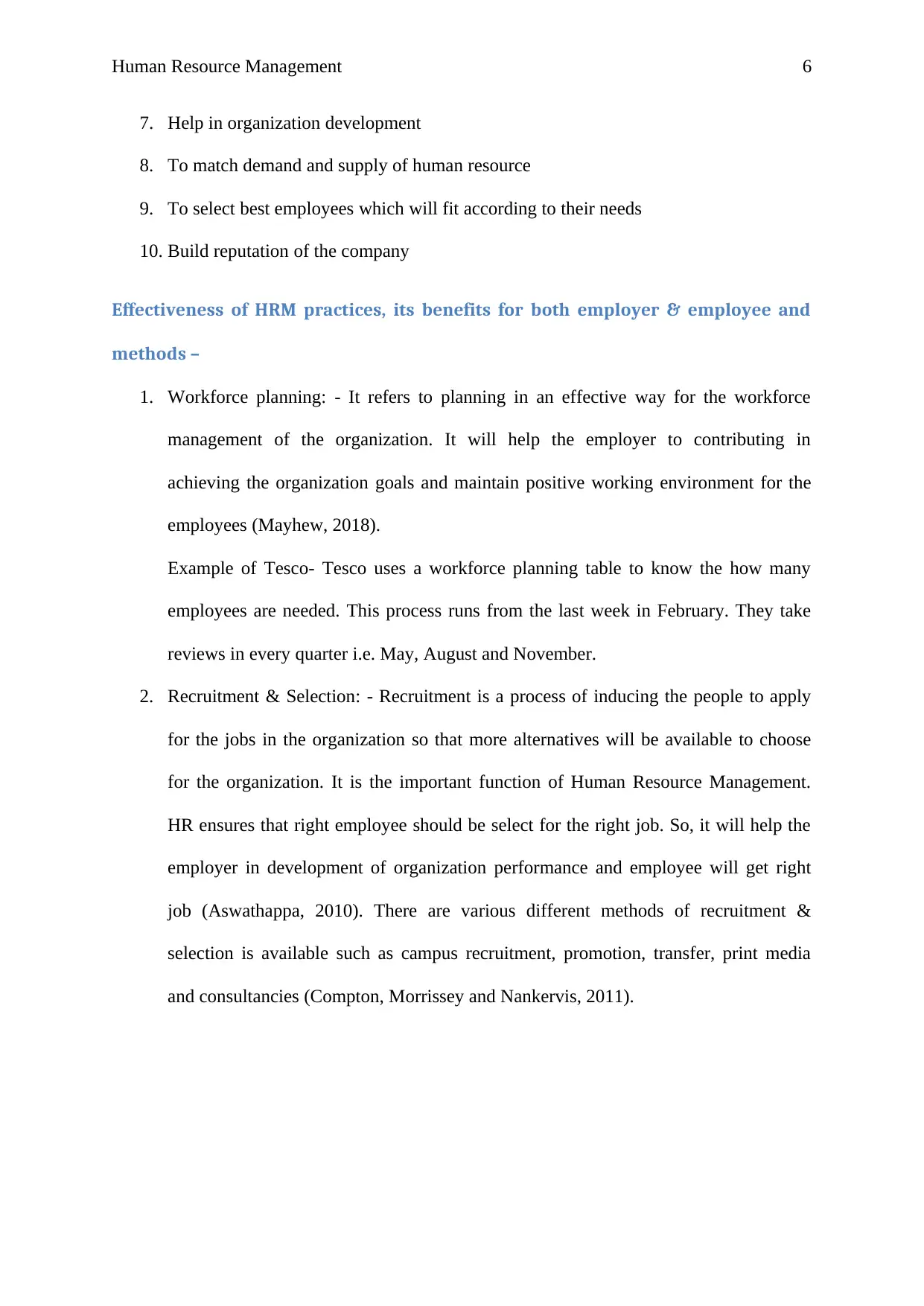
Human Resource Management 6
7. Help in organization development
8. To match demand and supply of human resource
9. To select best employees which will fit according to their needs
10. Build reputation of the company
Effectiveness of HRM practices, its benefits for both employer & employee and
methods –
1. Workforce planning: - It refers to planning in an effective way for the workforce
management of the organization. It will help the employer to contributing in
achieving the organization goals and maintain positive working environment for the
employees (Mayhew, 2018).
Example of Tesco- Tesco uses a workforce planning table to know the how many
employees are needed. This process runs from the last week in February. They take
reviews in every quarter i.e. May, August and November.
2. Recruitment & Selection: - Recruitment is a process of inducing the people to apply
for the jobs in the organization so that more alternatives will be available to choose
for the organization. It is the important function of Human Resource Management.
HR ensures that right employee should be select for the right job. So, it will help the
employer in development of organization performance and employee will get right
job (Aswathappa, 2010). There are various different methods of recruitment &
selection is available such as campus recruitment, promotion, transfer, print media
and consultancies (Compton, Morrissey and Nankervis, 2011).
7. Help in organization development
8. To match demand and supply of human resource
9. To select best employees which will fit according to their needs
10. Build reputation of the company
Effectiveness of HRM practices, its benefits for both employer & employee and
methods –
1. Workforce planning: - It refers to planning in an effective way for the workforce
management of the organization. It will help the employer to contributing in
achieving the organization goals and maintain positive working environment for the
employees (Mayhew, 2018).
Example of Tesco- Tesco uses a workforce planning table to know the how many
employees are needed. This process runs from the last week in February. They take
reviews in every quarter i.e. May, August and November.
2. Recruitment & Selection: - Recruitment is a process of inducing the people to apply
for the jobs in the organization so that more alternatives will be available to choose
for the organization. It is the important function of Human Resource Management.
HR ensures that right employee should be select for the right job. So, it will help the
employer in development of organization performance and employee will get right
job (Aswathappa, 2010). There are various different methods of recruitment &
selection is available such as campus recruitment, promotion, transfer, print media
and consultancies (Compton, Morrissey and Nankervis, 2011).
Paraphrase This Document
Need a fresh take? Get an instant paraphrase of this document with our AI Paraphraser
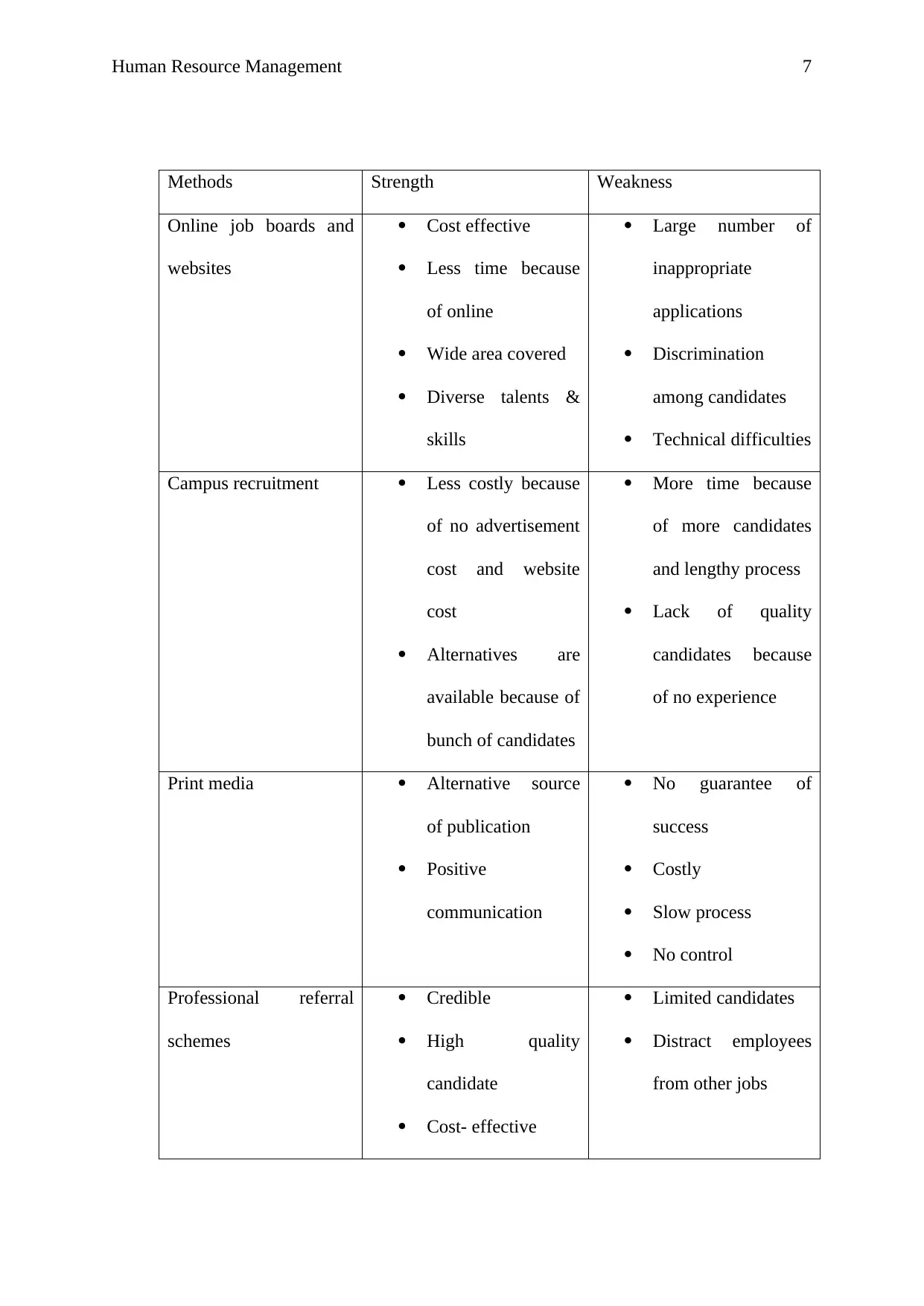
Human Resource Management 7
Methods Strength Weakness
Online job boards and
websites
Cost effective
Less time because
of online
Wide area covered
Diverse talents &
skills
Large number of
inappropriate
applications
Discrimination
among candidates
Technical difficulties
Campus recruitment Less costly because
of no advertisement
cost and website
cost
Alternatives are
available because of
bunch of candidates
More time because
of more candidates
and lengthy process
Lack of quality
candidates because
of no experience
Print media Alternative source
of publication
Positive
communication
No guarantee of
success
Costly
Slow process
No control
Professional referral
schemes
Credible
High quality
candidate
Cost- effective
Limited candidates
Distract employees
from other jobs
Methods Strength Weakness
Online job boards and
websites
Cost effective
Less time because
of online
Wide area covered
Diverse talents &
skills
Large number of
inappropriate
applications
Discrimination
among candidates
Technical difficulties
Campus recruitment Less costly because
of no advertisement
cost and website
cost
Alternatives are
available because of
bunch of candidates
More time because
of more candidates
and lengthy process
Lack of quality
candidates because
of no experience
Print media Alternative source
of publication
Positive
communication
No guarantee of
success
Costly
Slow process
No control
Professional referral
schemes
Credible
High quality
candidate
Cost- effective
Limited candidates
Distract employees
from other jobs
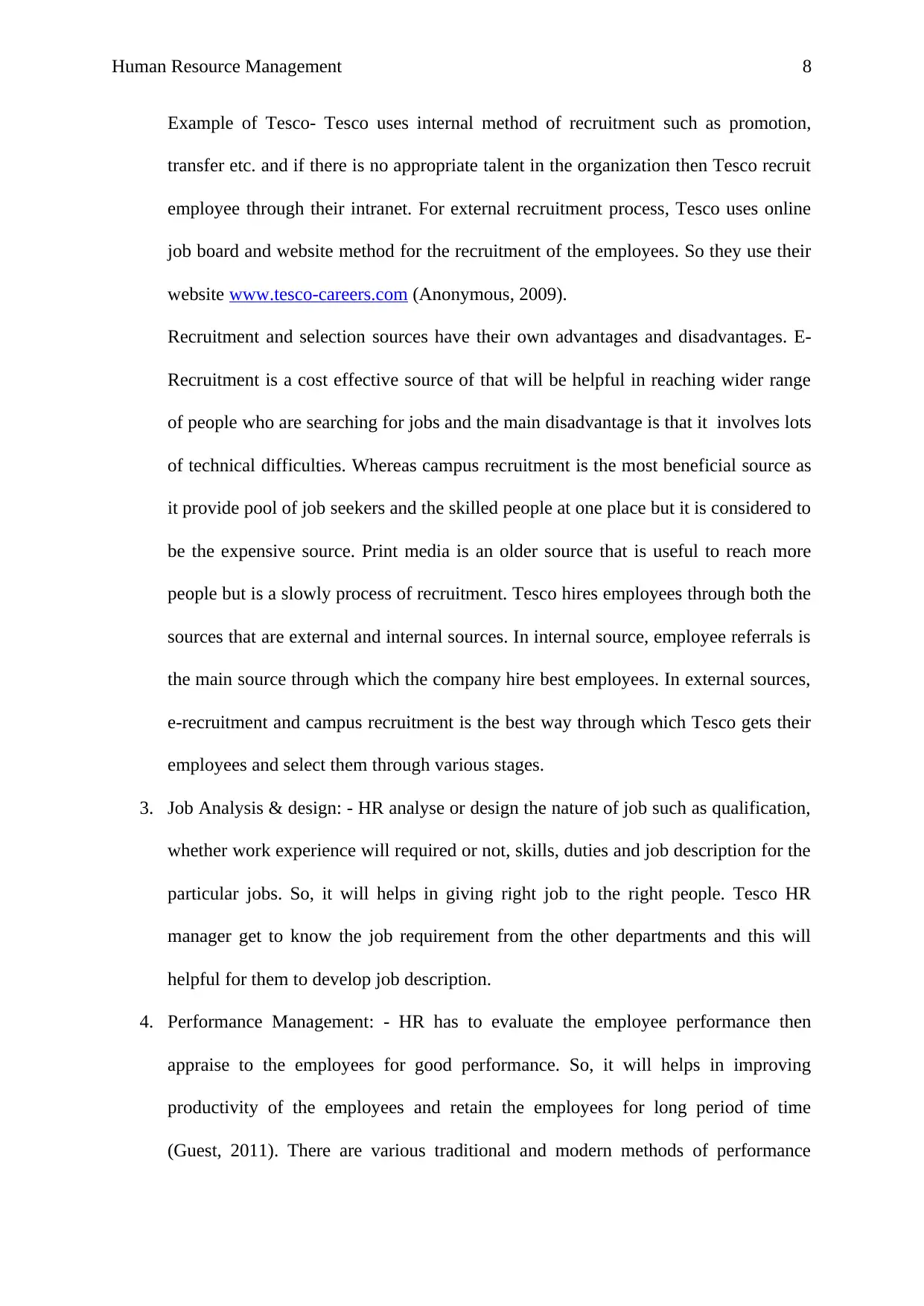
Human Resource Management 8
Example of Tesco- Tesco uses internal method of recruitment such as promotion,
transfer etc. and if there is no appropriate talent in the organization then Tesco recruit
employee through their intranet. For external recruitment process, Tesco uses online
job board and website method for the recruitment of the employees. So they use their
website www.tesco-careers.com (Anonymous, 2009).
Recruitment and selection sources have their own advantages and disadvantages. E-
Recruitment is a cost effective source of that will be helpful in reaching wider range
of people who are searching for jobs and the main disadvantage is that it involves lots
of technical difficulties. Whereas campus recruitment is the most beneficial source as
it provide pool of job seekers and the skilled people at one place but it is considered to
be the expensive source. Print media is an older source that is useful to reach more
people but is a slowly process of recruitment. Tesco hires employees through both the
sources that are external and internal sources. In internal source, employee referrals is
the main source through which the company hire best employees. In external sources,
e-recruitment and campus recruitment is the best way through which Tesco gets their
employees and select them through various stages.
3. Job Analysis & design: - HR analyse or design the nature of job such as qualification,
whether work experience will required or not, skills, duties and job description for the
particular jobs. So, it will helps in giving right job to the right people. Tesco HR
manager get to know the job requirement from the other departments and this will
helpful for them to develop job description.
4. Performance Management: - HR has to evaluate the employee performance then
appraise to the employees for good performance. So, it will helps in improving
productivity of the employees and retain the employees for long period of time
(Guest, 2011). There are various traditional and modern methods of performance
Example of Tesco- Tesco uses internal method of recruitment such as promotion,
transfer etc. and if there is no appropriate talent in the organization then Tesco recruit
employee through their intranet. For external recruitment process, Tesco uses online
job board and website method for the recruitment of the employees. So they use their
website www.tesco-careers.com (Anonymous, 2009).
Recruitment and selection sources have their own advantages and disadvantages. E-
Recruitment is a cost effective source of that will be helpful in reaching wider range
of people who are searching for jobs and the main disadvantage is that it involves lots
of technical difficulties. Whereas campus recruitment is the most beneficial source as
it provide pool of job seekers and the skilled people at one place but it is considered to
be the expensive source. Print media is an older source that is useful to reach more
people but is a slowly process of recruitment. Tesco hires employees through both the
sources that are external and internal sources. In internal source, employee referrals is
the main source through which the company hire best employees. In external sources,
e-recruitment and campus recruitment is the best way through which Tesco gets their
employees and select them through various stages.
3. Job Analysis & design: - HR analyse or design the nature of job such as qualification,
whether work experience will required or not, skills, duties and job description for the
particular jobs. So, it will helps in giving right job to the right people. Tesco HR
manager get to know the job requirement from the other departments and this will
helpful for them to develop job description.
4. Performance Management: - HR has to evaluate the employee performance then
appraise to the employees for good performance. So, it will helps in improving
productivity of the employees and retain the employees for long period of time
(Guest, 2011). There are various traditional and modern methods of performance
⊘ This is a preview!⊘
Do you want full access?
Subscribe today to unlock all pages.

Trusted by 1+ million students worldwide
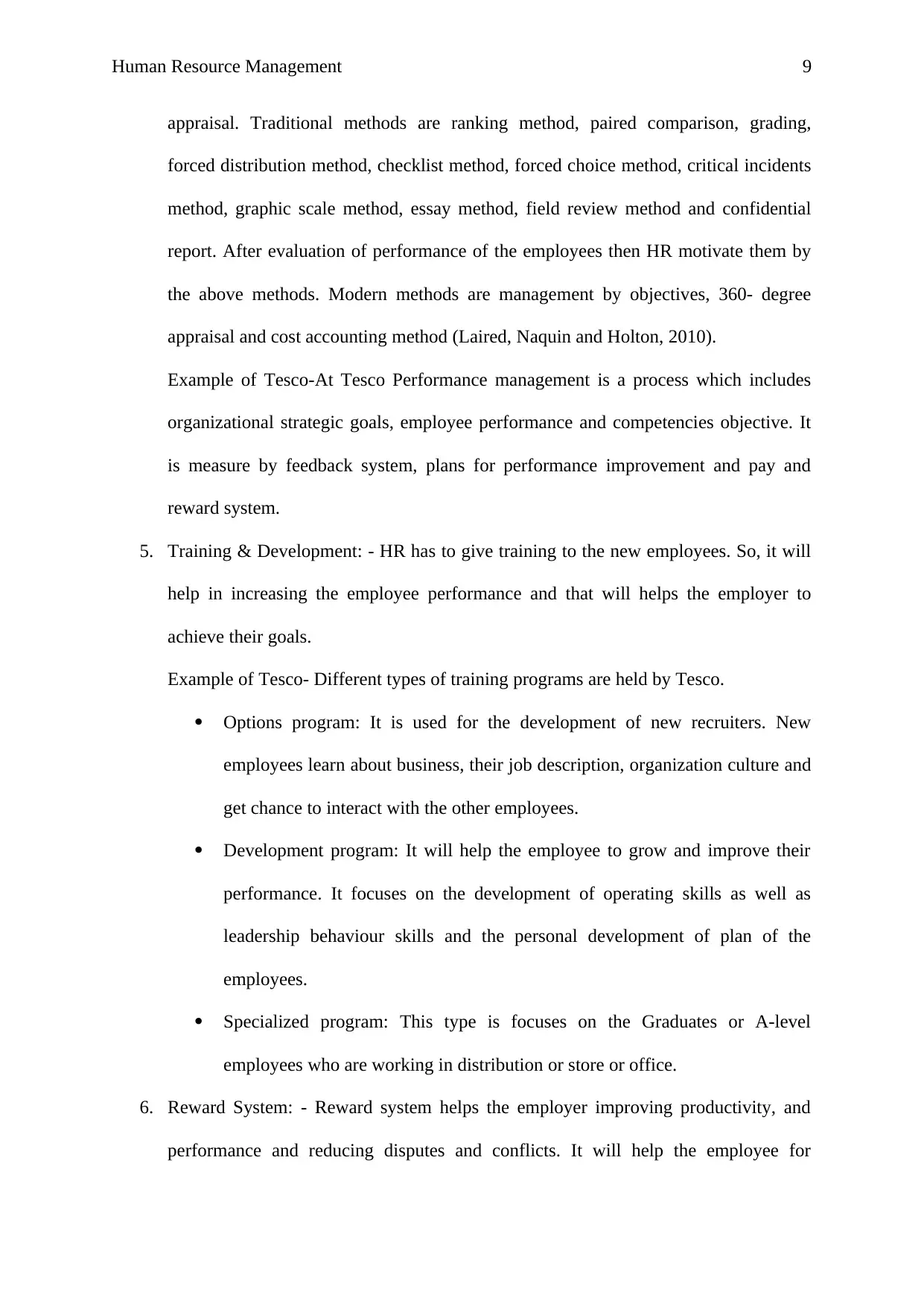
Human Resource Management 9
appraisal. Traditional methods are ranking method, paired comparison, grading,
forced distribution method, checklist method, forced choice method, critical incidents
method, graphic scale method, essay method, field review method and confidential
report. After evaluation of performance of the employees then HR motivate them by
the above methods. Modern methods are management by objectives, 360- degree
appraisal and cost accounting method (Laired, Naquin and Holton, 2010).
Example of Tesco-At Tesco Performance management is a process which includes
organizational strategic goals, employee performance and competencies objective. It
is measure by feedback system, plans for performance improvement and pay and
reward system.
5. Training & Development: - HR has to give training to the new employees. So, it will
help in increasing the employee performance and that will helps the employer to
achieve their goals.
Example of Tesco- Different types of training programs are held by Tesco.
Options program: It is used for the development of new recruiters. New
employees learn about business, their job description, organization culture and
get chance to interact with the other employees.
Development program: It will help the employee to grow and improve their
performance. It focuses on the development of operating skills as well as
leadership behaviour skills and the personal development of plan of the
employees.
Specialized program: This type is focuses on the Graduates or A-level
employees who are working in distribution or store or office.
6. Reward System: - Reward system helps the employer improving productivity, and
performance and reducing disputes and conflicts. It will help the employee for
appraisal. Traditional methods are ranking method, paired comparison, grading,
forced distribution method, checklist method, forced choice method, critical incidents
method, graphic scale method, essay method, field review method and confidential
report. After evaluation of performance of the employees then HR motivate them by
the above methods. Modern methods are management by objectives, 360- degree
appraisal and cost accounting method (Laired, Naquin and Holton, 2010).
Example of Tesco-At Tesco Performance management is a process which includes
organizational strategic goals, employee performance and competencies objective. It
is measure by feedback system, plans for performance improvement and pay and
reward system.
5. Training & Development: - HR has to give training to the new employees. So, it will
help in increasing the employee performance and that will helps the employer to
achieve their goals.
Example of Tesco- Different types of training programs are held by Tesco.
Options program: It is used for the development of new recruiters. New
employees learn about business, their job description, organization culture and
get chance to interact with the other employees.
Development program: It will help the employee to grow and improve their
performance. It focuses on the development of operating skills as well as
leadership behaviour skills and the personal development of plan of the
employees.
Specialized program: This type is focuses on the Graduates or A-level
employees who are working in distribution or store or office.
6. Reward System: - Reward system helps the employer improving productivity, and
performance and reducing disputes and conflicts. It will help the employee for
Paraphrase This Document
Need a fresh take? Get an instant paraphrase of this document with our AI Paraphraser
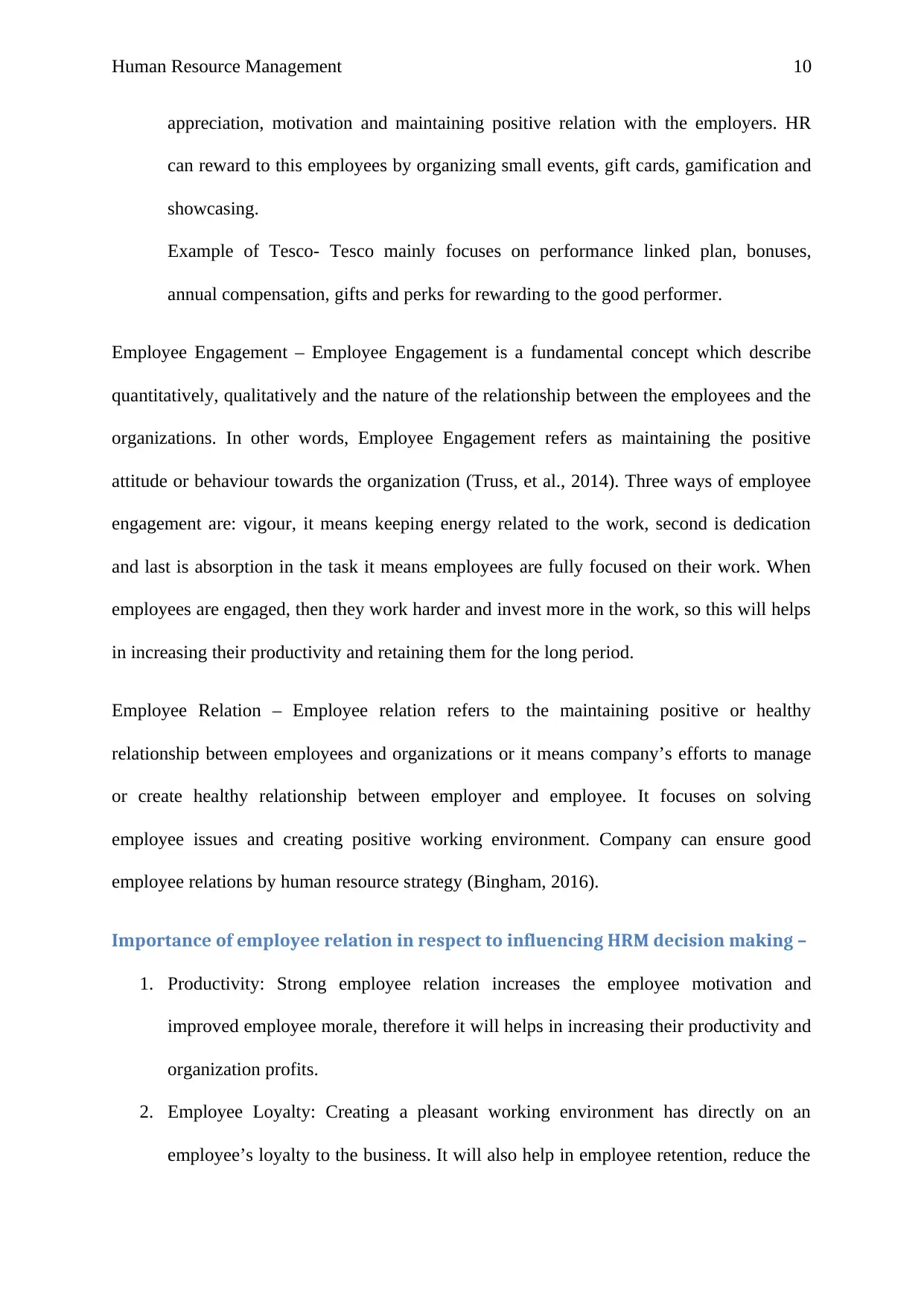
Human Resource Management 10
appreciation, motivation and maintaining positive relation with the employers. HR
can reward to this employees by organizing small events, gift cards, gamification and
showcasing.
Example of Tesco- Tesco mainly focuses on performance linked plan, bonuses,
annual compensation, gifts and perks for rewarding to the good performer.
Employee Engagement – Employee Engagement is a fundamental concept which describe
quantitatively, qualitatively and the nature of the relationship between the employees and the
organizations. In other words, Employee Engagement refers as maintaining the positive
attitude or behaviour towards the organization (Truss, et al., 2014). Three ways of employee
engagement are: vigour, it means keeping energy related to the work, second is dedication
and last is absorption in the task it means employees are fully focused on their work. When
employees are engaged, then they work harder and invest more in the work, so this will helps
in increasing their productivity and retaining them for the long period.
Employee Relation – Employee relation refers to the maintaining positive or healthy
relationship between employees and organizations or it means company’s efforts to manage
or create healthy relationship between employer and employee. It focuses on solving
employee issues and creating positive working environment. Company can ensure good
employee relations by human resource strategy (Bingham, 2016).
Importance of employee relation in respect to influencing HRM decision making –
1. Productivity: Strong employee relation increases the employee motivation and
improved employee morale, therefore it will helps in increasing their productivity and
organization profits.
2. Employee Loyalty: Creating a pleasant working environment has directly on an
employee’s loyalty to the business. It will also help in employee retention, reduce the
appreciation, motivation and maintaining positive relation with the employers. HR
can reward to this employees by organizing small events, gift cards, gamification and
showcasing.
Example of Tesco- Tesco mainly focuses on performance linked plan, bonuses,
annual compensation, gifts and perks for rewarding to the good performer.
Employee Engagement – Employee Engagement is a fundamental concept which describe
quantitatively, qualitatively and the nature of the relationship between the employees and the
organizations. In other words, Employee Engagement refers as maintaining the positive
attitude or behaviour towards the organization (Truss, et al., 2014). Three ways of employee
engagement are: vigour, it means keeping energy related to the work, second is dedication
and last is absorption in the task it means employees are fully focused on their work. When
employees are engaged, then they work harder and invest more in the work, so this will helps
in increasing their productivity and retaining them for the long period.
Employee Relation – Employee relation refers to the maintaining positive or healthy
relationship between employees and organizations or it means company’s efforts to manage
or create healthy relationship between employer and employee. It focuses on solving
employee issues and creating positive working environment. Company can ensure good
employee relations by human resource strategy (Bingham, 2016).
Importance of employee relation in respect to influencing HRM decision making –
1. Productivity: Strong employee relation increases the employee motivation and
improved employee morale, therefore it will helps in increasing their productivity and
organization profits.
2. Employee Loyalty: Creating a pleasant working environment has directly on an
employee’s loyalty to the business. It will also help in employee retention, reduce the
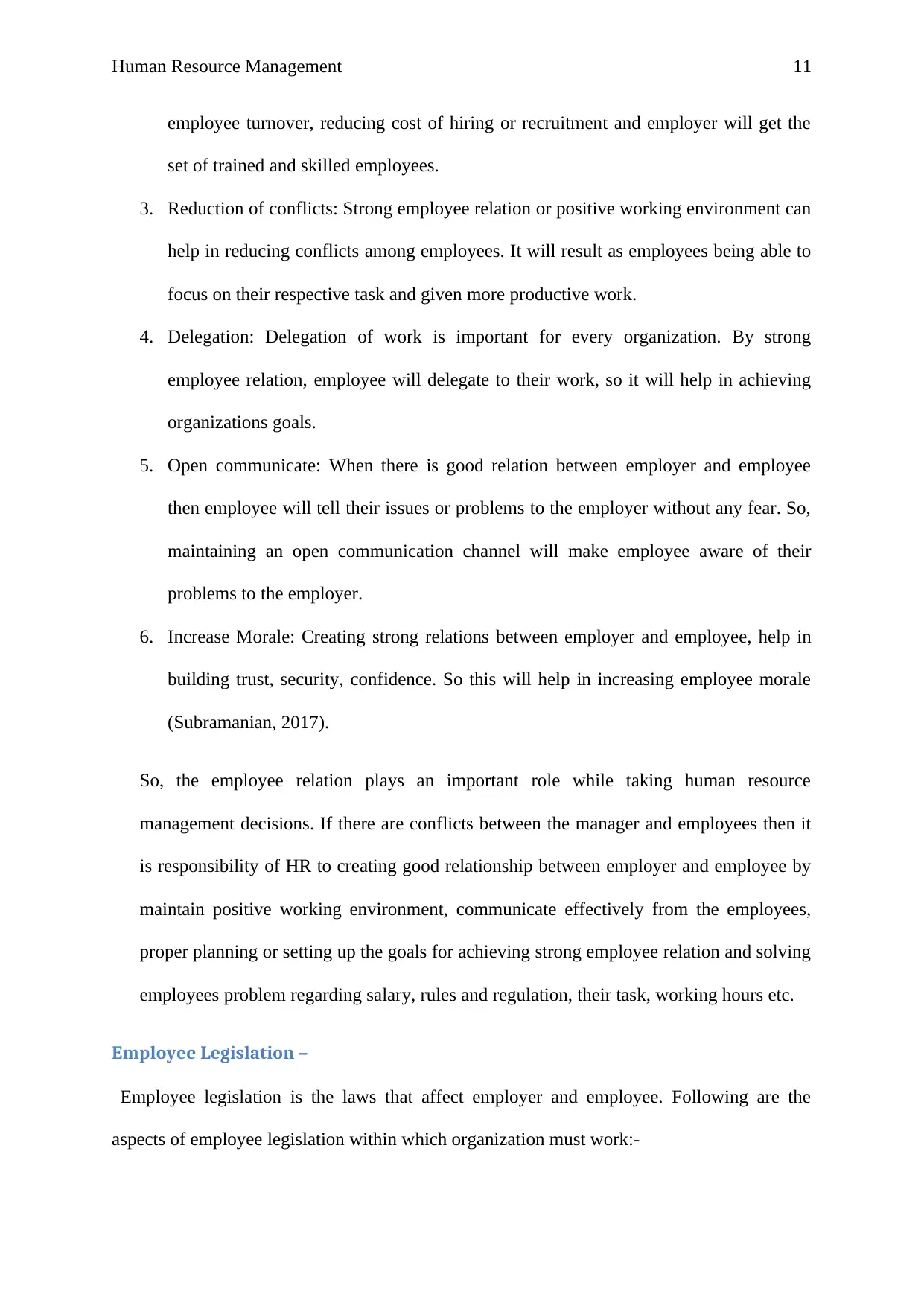
Human Resource Management 11
employee turnover, reducing cost of hiring or recruitment and employer will get the
set of trained and skilled employees.
3. Reduction of conflicts: Strong employee relation or positive working environment can
help in reducing conflicts among employees. It will result as employees being able to
focus on their respective task and given more productive work.
4. Delegation: Delegation of work is important for every organization. By strong
employee relation, employee will delegate to their work, so it will help in achieving
organizations goals.
5. Open communicate: When there is good relation between employer and employee
then employee will tell their issues or problems to the employer without any fear. So,
maintaining an open communication channel will make employee aware of their
problems to the employer.
6. Increase Morale: Creating strong relations between employer and employee, help in
building trust, security, confidence. So this will help in increasing employee morale
(Subramanian, 2017).
So, the employee relation plays an important role while taking human resource
management decisions. If there are conflicts between the manager and employees then it
is responsibility of HR to creating good relationship between employer and employee by
maintain positive working environment, communicate effectively from the employees,
proper planning or setting up the goals for achieving strong employee relation and solving
employees problem regarding salary, rules and regulation, their task, working hours etc.
Employee Legislation –
Employee legislation is the laws that affect employer and employee. Following are the
aspects of employee legislation within which organization must work:-
employee turnover, reducing cost of hiring or recruitment and employer will get the
set of trained and skilled employees.
3. Reduction of conflicts: Strong employee relation or positive working environment can
help in reducing conflicts among employees. It will result as employees being able to
focus on their respective task and given more productive work.
4. Delegation: Delegation of work is important for every organization. By strong
employee relation, employee will delegate to their work, so it will help in achieving
organizations goals.
5. Open communicate: When there is good relation between employer and employee
then employee will tell their issues or problems to the employer without any fear. So,
maintaining an open communication channel will make employee aware of their
problems to the employer.
6. Increase Morale: Creating strong relations between employer and employee, help in
building trust, security, confidence. So this will help in increasing employee morale
(Subramanian, 2017).
So, the employee relation plays an important role while taking human resource
management decisions. If there are conflicts between the manager and employees then it
is responsibility of HR to creating good relationship between employer and employee by
maintain positive working environment, communicate effectively from the employees,
proper planning or setting up the goals for achieving strong employee relation and solving
employees problem regarding salary, rules and regulation, their task, working hours etc.
Employee Legislation –
Employee legislation is the laws that affect employer and employee. Following are the
aspects of employee legislation within which organization must work:-
⊘ This is a preview!⊘
Do you want full access?
Subscribe today to unlock all pages.

Trusted by 1+ million students worldwide
1 out of 22
Related Documents
Your All-in-One AI-Powered Toolkit for Academic Success.
+13062052269
info@desklib.com
Available 24*7 on WhatsApp / Email
![[object Object]](/_next/static/media/star-bottom.7253800d.svg)
Unlock your academic potential
Copyright © 2020–2025 A2Z Services. All Rights Reserved. Developed and managed by ZUCOL.





